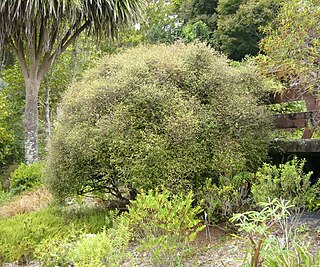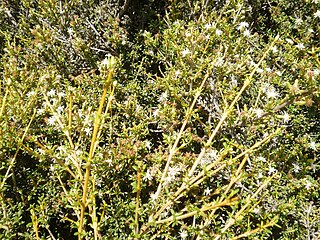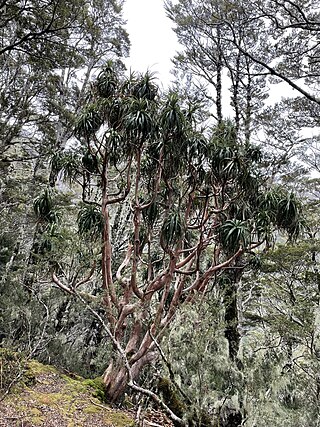
Olearia, most commonly known as daisy-bush, is a genus of flowering plants belonging to the family Asteraceae, the largest of the flowering plant families in the world. Olearia are found in Australia, New Guinea and New Zealand. The genus includes herbaceous plants, shrubs and small trees. The latter are unusual among the Asteraceae and are called tree daisies in New Zealand. All bear the familiar daisy-like composite flowerheads in white, pink, mauve or purple.

Dracophyllum is a genus of plants belonging to the family Ericaceae, formerly Epacridaceae. There are 61 species in the genus, mostly shrubs, but also cushion plants and trees, found in New Zealand, Australia, Lord Howe Island and New Caledonia. The name Dracophyllum, meaning dragon-leaf, refers to their strong outward similarity to the unrelated Dracaena, sometimes known as dragon tree. Although dicotyledonous, they resemble primitive monocots with their slender leaves concentrated in clumps at the ends of the branches; they are sometimes called grass-trees.

Muehlenbeckia astonii or shrubby tororaro is an endemic New Zealand shrub in the family Polygonaceae. It has distinctive small heart-shaped deciduous leaves amidst a tangle of wiry interlocking branches. Although common in cultivation around the world, it is extremely rare and threatened in the wild.

Olearia hectorii is a species of flowering plant in the daisy family Asteraceae. Its common names include deciduous tree daisy and Hector's tree daisy. It is endemic to New Zealand, where it is nationally endangered.

Archeria traversii is a species of shrub in the family Ericaceae.

Pachystegia insignis is a species of flowering plants in the family Asteraceae. It is endemic to New Zealand.

The Canterbury-Otago tussock grasslands is an ecoregion of the South Island, New Zealand, part of the wider tussock grasslands of New Zealand.

Olearia tomentosa, commonly known as the toothed daisy-bush, is a species of flowering plant in the family Asteraceae and is endemic to south-eastern continental Australia. It is a spreading shrub with egg-shaped leaves, the edges toothed or lobed, and blue or white and yellow, daisy-like inflorescences.

Olearia paniculata, commonly called akiraho, is a species of shrub or tree in the family Asteraceae, found only in New Zealand. The tree can grow to 6 metres high, and has yellow-green, oval-shaped leaves, with white undersides and wavy margins.

Olearia solandri, commonly known as coastal daisy-bush or coastal tree daisy, is a coastal shrub of New Zealand.

Olearia decurrens, commonly known as the clammy daisy bush, is a species of flowering plant in the family Asteraceae and is endemic to arid, inland Australia. It is a glabrous, sticky, twiggy shrub with narrow egg-shaped to linear leaves sometimes with toothed edges, and white and yellow, daisy-like inflorescences.
Olearia adenocarpa or small-leaved tree daisy is a small divaricating shrub endemic to New Zealand, from the plant family Asteraceae. The bush grows up to 1.5 metres in height and 1.2 m wide. It has a smaller and open growth habit in comparison to Olearia odorata. It is trailing deciduous to semi-deciduous.

Olearia avicenniifolia, known commonly as mountain akeake, is a flowering plant in the family Asteraceae. It is endemic to New Zealand where it is found on the southern coastlines of the South Island and on Stewart Island. It is classified as Not Threatened.

Leptinella filiformis, or slender button daisy, is a species of flowering plant in the daisy family, found only in the north-eastern part of the South Island of New Zealand. Thought to be extinct by the 1980s, it was rediscovered growing on a Hanmer Springs hotel lawn in 1998, and in the wild in 2015.

Dracophyllum arboreum, commonly known as Chatham Island grass tree and tarahinau (Moriori), is a species of tree in the heath family Ericaceae. Endemic to the Chatham Islands of New Zealand, it reaches a height of 18 m (60 ft) and has leaves that differ between the juvenile and adult forms.

Dracophyllum traversii, commonly known as mountain neinei, grass tree, and pineapple tree is a species of flowering plant in the heath family Ericaceae. It is a deciduous tree endemic to New Zealand. It reaches a height of 0.2–13 m (0.66–42.65 ft) and has leaves which form tufts at the end of its branches. It has a lifespan of between 500 and 600 years.

Ward Beach is a section of rugged coastline in the Marlborough Region of New Zealand that is known for unusual rock formations. The geological features include the exposed reef platforms that were uplifted by 2 m or more during the 2016 Kaikōura earthquake, and the spherical concretions known as the Ward Beach boulders. Another formation known as the Chancet Rocks is located in a scientific reserve about 1.5 km to the north of the Ward Beach roadend. They contain unusual trace fossils and provide amongst the best on-land evidence of the Cretaceous–Paleogene boundary in marine sediments in the Southern Hemisphere.
Hierodoris pachystegiae is a moth of the family Oecophoridae. It is endemic to New Zealand and has only been collected at Kaikōura. The larval host are plants in the genus Pachystegia which is found only in the Marlborough region. The larvae of this species have yet to be described from life but the adults of this species are predominantly grey in colour. The forewings of this species have silver markings similar to that of H. electrica.

Celmisia major is a species of daisy that is endemic to New Zealand. It is split into two different varieties, Celmisia major var. major and Celmisia major var. brevis. Despite being in the same species, it is thought that the two varieties are not close to one another, with botanist Peter James de Lange stressing critical study on the taxonomy of the daisies. It was first described by Thomas Cheeseman in 1925. The major variety is found in the Auckland area and nearby islands, while the brevis variety is confined to Mount Taranaki.

Olearia tasmainca is a species of flowering plant in the family Asteraceae and is endemic to Tasmania. It is a shrub that typically grows to a height of 1.0–1.5 m and has oblong to egg-shaped leaves with the narrower end towards the base, 19–40 mm (0.75–1.57 in) long and with a blunt tip. The heads or daisy-like "flowers" have up to 8 ray florets. Flowering mainly occurs in January and the fruit is a smooth achene.


















